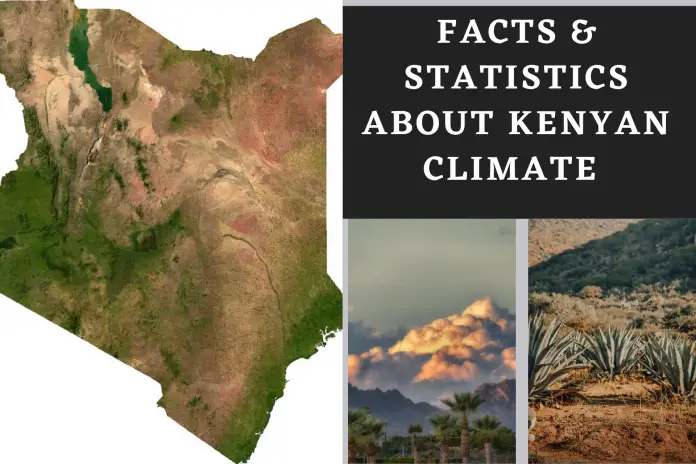Key Takeaways
- In November 1994, Meru recorded the highest rainfall ever in Kenya, with over 22mm per day.
- The highest temperature recorded in Kenya was in Mandera in April 2019, at 41.6°C.
- In July 2002, the JKIA weather station recorded the lowest temperature at 2.8°C.
- The hottest month is February, with maximum and minimum temperatures of 33.2°C and 26.76°C.
- July is the coldest month, with temperatures between 18.08°C and 27.78°C.
Kenya has one of the most diverse climates in the world. The arid and semi-arid parts of Nothern Kenya experience the highest temperatures and lowest rainfall. On the other hand, the Western region has the highest precipitation.
Mt. Kenya region and Rift Valley highlands experience the lowest temperatures in Kenya. Despite the extremes, the weather in Kenya can be described as generally moderate throughout the year.
Facts & Statistics about Kenyan Climate
Seasons

Kenya has 2 distinct seasons throughout the year. Between December and March, there is a dry season. In April, the season of long rains sets in and lasts until early June.
After that, there is a dry period between late June and October. The season of short rains comes between November and early December.
Indian Ocean winds are the primary determinants of the climate in Kenya. In the western region, Lake Victoria causes constant showers even when the weather is relatively hot.
The best time to visit Kenya is between mid-July and October when it is dry. You can enjoy a safari drive or watch the famous wildebeest migration.
Rainfall
The average annual rainfall is around 720mm in Kenya.
The western region experiences the highest precipitation, with a yearly range of over 1650mm. The rain is distributed throughout the year. However, March, April, and May have the highest level of rainfall.
The northeastern part of Kenya is the driest, with less than 300mm of annual precipitation.
| Month | Jan | Feb | Mar | Apr | May | Jun | Jul | Aug | Sep | Oct | Nov | Dec |
| Rainfall (mm) | 32 | 25 | 64 | 134 | 93 | 36 | 32 | 35 | 28 | 77 | 110 | 60 |
Average Rainfall Distribution in Kenya (1991-2020)
April and November have the highest rainfall, while February and September are the driest.
In November 1994, Meru recorded the highest precipitation, over 22mm per day.
Temperatures
Data from the Climate Change Knowledge Portal by the World Bank, Kenya has a mean annual temperature of 25.08°C (77.14°F).
The hottest month is February, with maximum and minimum temperatures of 33.2°C and 26.76°C.
On the other hand, July is the coldest month, with temperatures ranging between 18.08°C and 27.78°C.
The Central region experiences the lowest temperature, while North Eastern has the highest.
| Month | Jan | Feb | Mar | Apr | May | Jun | Jul | Aug | Sep | Oct | Nov | Dec |
| Temperature (°C) | 25.5 | 26.3 | 26.8 | 26.1 | 25.1 | 24.1 | 23.4 | 23.8 | 24.6 | 25.4 | 25.1 | 25.0 |
Average Temperature in Kenya (1991-2020)
The hottest temperature recorded in Kenya was in Mandera in April 2019, at 41.6°C. In July 2002, the JKIA weather station recorded the lowest temperature at 2.8°C.
Regional climate

Although there are no regions with extreme weather in Kenya, the climate differs because of the diversity of the landscape.
The coastal and Lake Victoria regions have hot and wet climatic conditions. Temperatures remain relatively high throughout the year (22°C to 31°C).
The cool breeze from the lake and ocean reduces the impact of heat. Rainfall is usually over 1500mm per year.
The weather is usually hot and dry in Kenya’s northern and northeastern parts. Temperatures can go to the highs of 40°C and lows of 20°C. The regions receive less than 300mm of precipitation annually.
Nairobi and Eastern Kenya have a moderate climate. The rainfall is about 650mm annually, while the average temperature is 18.8°C. However, areas like Kitui and Machakos experience higher temperatures and lower rainfall.
The areas around Mt. Kenya and Mt. Elgon receive high rainfall and are relatively cold. The average temperatures in these regions are around 16.5°C, with precipitation above 1500mm.
Conclusion
Kenya experiences a generally moderate climate throughout the year. The northern and northeastern parts are the hottest and driest. The Western region receives the highest precipitation. On the other hand, the mountainous areas are the coldest.























